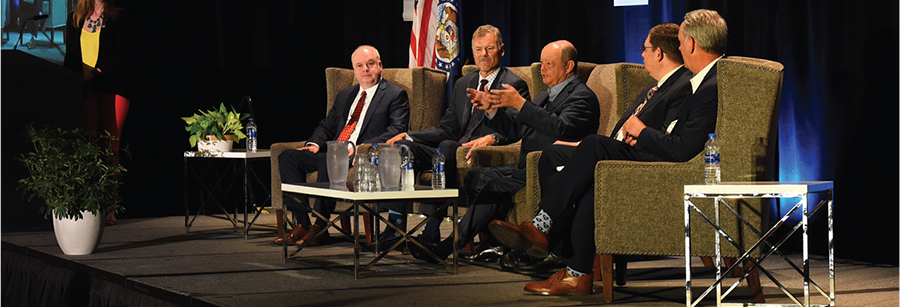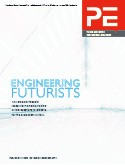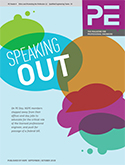September/October 2019
Engineering Outlook 2025
BY DANIELLE BOYKIN
 AEC LEADERS DISCUSS THEIR VIEWS ON EMERGING LEADERS, WORKFORCE DIVERSITY, AND ETHICAL PRACTICE DURING THE ENGINEERING OUTLOOK 2025 SESSION AT THE RECENT 2019 PROFESSIONAL ENGINEERS CONFERENCE: (LEFT TO RIGHT) THOMAS O’GRADY, P.E., RAYMOND KOWALIK, P.E., STEVEN EDWARDS, P.E., RALPH DAVIS, P.E., AND RANDY BREDAR.
AEC LEADERS DISCUSS THEIR VIEWS ON EMERGING LEADERS, WORKFORCE DIVERSITY, AND ETHICAL PRACTICE DURING THE ENGINEERING OUTLOOK 2025 SESSION AT THE RECENT 2019 PROFESSIONAL ENGINEERS CONFERENCE: (LEFT TO RIGHT) THOMAS O’GRADY, P.E., RAYMOND KOWALIK, P.E., STEVEN EDWARDS, P.E., RALPH DAVIS, P.E., AND RANDY BREDAR.
Today’s young engineering professionals are bringing to the workforce a treasure trove of knowledge and skills as well as a strong desire to take the lead and make positive impacts in their careers and communities. How can AEC leaders tap into that energy to help their emerging leaders flourish while fostering the growth of their organizations and the profession?
The Engineering Outlook 2025 session during the recent 2019 Professional Engineers Conference in Kansas City, Missouri, provided the opportunity to hear the views of AEC leaders on what it takes to develop strong leaders and how the industry will thrive going forward.
Attendees listened to the insights of Randy Bredar, an executive vice president at JE Dunn Construction; Ralph Davis, P.E., deputy director of the Kansas City Public Works Department; Steven Edwards, P.E., chief executive officer of Black & Veatch; Raymond Kowalik, P.E., chief executive officer of Burns & McDonnell Inc.; and Thomas O’Grady, P.E., corporate president of HNTB. The discussion was guided by NSPE Past President Kodi Verhalen, P.E., F.NSPE, Esq.
Here’s a snapshot of what these AEC industry leaders had to say on emerging leadership, fostering diversity in the workforce, and promoting ethical cultures.
Leadership for the Future
 RALPH DAVIS, P.E., DEPUTY DIRECTOR OF THE KANSAS CITY PUBLIC WORKS DEPARTMENT
RALPH DAVIS, P.E., DEPUTY DIRECTOR OF THE KANSAS CITY PUBLIC WORKS DEPARTMENT RANDY BREDAR, AN EXECUTIVE PRESIDENT AT JE DUNN CONSTRUCTION
RANDY BREDAR, AN EXECUTIVE PRESIDENT AT JE DUNN CONSTRUCTION RAYMOND KOWALIK, P.E., CHIEF EXECUTIVE OFFICER OF BURNS & MCDONNELL INC
RAYMOND KOWALIK, P.E., CHIEF EXECUTIVE OFFICER OF BURNS & MCDONNELL INC THOMAS O’GRADY, P.E., CORPORATE PRESIDENT OF HNTB
THOMAS O’GRADY, P.E., CORPORATE PRESIDENT OF HNTBIn order to thrive, organizations will need to rethink how they build up the next generation of leaders. Providing opportunities for emerging leaders to grow and strengthen their knowledge, skills, and abilities to make valuable contributions to a firm will not always be done as it has been in the past. Leadership models are evolving.
One of the best things that senior leadership can do for emerging professionals, said Steven Edwards, P.E., is to do more listening and figuring out what kinds of opportunities that they are interested in pursuing. This means resisting any desire to make personal clones out of their young talent. “We should be opening doors for them, mentoring them, and working across the company to find those kinds of experiences and projects that will really make them feel like they’re [fulfilled] in their career,” said the Black & Veatch chief executive officer.
At Burns & McDonnell Inc., there are two parts to leadership development. One that’s focused on immersing emerging leaders into the company culture and providing leadership opportunities within the firm. The second part focuses on outreach experiences. Involvement in community and civic organizations, said CEO Raymond Kowalik, P.E., is also valuable to leadership development. “When new people come into the organization, we tell them that they have a duty to their communities. And if you have young kids, it might mean that you’re coaching their soccer games, and when they are teenagers, you’re volunteering and serving lunches at the Ronald McDonald House.”
It’s vital that senior leadership sets the example for emerging leaders and new employees, Kowalik added. “If you don’t set it at the top of your organization, [the commitment] is not real. And if it’s not real and genuine, the rest of your organization won’t do it.”
Encouraging and supporting staff to be a part of NSPE and other professional organizations is also essential to providing them opportunities to lead, said Ralph Davis, P.E., deputy director of the Kansas City Public Works Department. The department pays for memberships and provides time and resources for professional development and to attend conferences. “The more [employees] are involved, the more we support them. They see the ability to grow by that support and it encourages them to keep on going.”
A Changing View of Leadership
Today’s young engineers don’t think of leadership in the same ways as previous generations. Steven Edwards believes that leadership models need to shift to allow people at all levels of an organization to spearhead projects and initiatives. “This generation wants to engage immediately,” he said, “often because they have had experiences in colleges that allowed them to collaborate and lead teams.” These opportunities could include a small project, an improvement idea, or anything where younger staffers can serve as leaders.
Edwards advises his peers to avoid resisting this change. “So many times, people my age may think, ‘Well, they are trying to be CEO or president tomorrow.’ That’s not really what they are saying. They want to be able to start being engaged early in their careers. I think that’s a really important shift that’s happening within our business culture today that we need to pay attention to and help grow.”
Senior leadership should actively engage with their young professionals, said Ralph Davis, as they bring fresh ideas and a lot of ambitions to the table. He understands that young engineers want to have opportunities to show leadership today, not in 10 years or even two to three. “As you interact and listen in whatever kind of forum that works the best, you’re able to hear what they want to do. They want to make a difference in their communities and in their organizations. The biggest thing is to interact with them early and get them moving.”
Creating a culture of openness over a leadership culture that is completely top down hierarchical has been a priority for Randy Bredar, an executive vice president at JE Dunn Construction’s Kansas City office. “The doors have gone away, offices have gone away, we move people around the building on a very, very regular basis for team-based projects,” he explained. “ [Emerging leaders and new employees] get that exposure. We are trying to break down that hierarchy.”
Like many large AEC firms, HNTB has offices across the US. To overcome any engagement challenges, the firm moves corporate and regional meetings around to each local office in order to have the necessary conversations with staff and young leaders. The company will ask them what’s working, what’s serving their clients and their needs, said Thomas O’Grady, P.E., corporate president. “Gathering all of that information and just making that part of who we are is allowing us to learn a lot more,” Grady said. “It’s about getting all of those ideas, being inclusive, and learning how that will help us to be stronger.”
Cultivating a Transparent and Transformative Environment
How do you cultivate an organizational environment that allows for constructive criticism and dialogue to help a firm or agency evolve and become primed for long-term growth?
If firm leaders want to have critical conversations and elicit the type of feedback that will benefit the organization, said Steven Edwards, they’ll have to establish a culture of trust. People have to trust who they are talking to and that senior leadership will listen to their feedback. “And they have to see that there are actions being taken based on their feedback.”
One way to prepare organizations for future success is to challenge and break down old rigid structures that only value a top-down approach and limit real input from talent at all levels. But there is too often fear and skepticism associated with proactively engaging senior leadership.
Ralph Davis wanted this type of thinking within his organization to change. He started by going out into the field offices just to chat with staff and listen, with the hopes of breaking down communication barriers. He admitted that it took a few consistent visits before they started to open up and engage with senior leaders. “They had to see us in a different light, and that took a while. But it was that persistence that paid off,” he said. “Organizationally we will be stronger in the long term because we have employees that approach us about what they are seeing and what they need.”
JE Dunn Construction is a 95-year-old construction firm that was family owned until a decade ago. The change in ownership and evolving into an employee-owned firm has required a journey of transparency, said Randy Bredar. This journey has involved informing 1,200 employees about the firm’s finances and being honest about the good and the not-so-good information. “That notion of transparency has been pretty transformational for our culture because we were previously a family-owned business where only 12 people got to understand what was really going on,” said Bredar. “[This transition] was painful and awkward at first, but it’s really helped our culture.”
Raymond Kowalik explained that he has worked with two types of bosses: the ones that if you tell them the truth you may get crucified and those that if you tell them the truth, they want to help you resolve the situation. Now, which one do you want to be? “For me, it’s all about your actions when you learn something good or bad and how you react. And what you do with information and how the organization treats it,” said Kowalik. “When we have a problem project, we take all of our best resources and throw them onto the project instead of running away from the project, because we know that is best for our organization.”
Being genuine, said Kowalik, is the only way to get any kind of constructive criticism or debate and to have a real conversation around it. “When we have our officer meetings or any interaction with our employee reps, we may not agree with some of the issues, but we’ll have a good dialogue about that. And it might not be to someone’s satisfaction, but it’s at least an honest, genuine conversation.”
Maintaining a culture that permits open and honest dialogue has been critical to HNTB’s survival, said Thomas O’Grady. “We are a very long-standing, old employee-owned firm, in an industry where we don’t see that sort of longevity across the entire industry. You see a lot of firms that ultimately have to be acquired by somebody or merge with another firm to maintain employee ownership. To maintain that longevity, the key to survival is being open and having trust. It’s a nonstop effort.”
Advocating for Diversity
NSPE recognizes the benefits of a diverse population of licensed engineers in shaping the future of engineering. This diversity fosters unique contributions and capabilities and creates an inclusive community, ultimately leading to a more creative, effective, and technically respected community. How are AEC leaders advocating for diversity and creating environments that will retain it?
There’s certainly a business case for diversity, but Steven Edwards believes that AEC leadership should focus on diversifying their workforces simply because it’s the right thing to do. Until everyone gets on board with that idea, he believes the industry will continue to struggle in this area. “If you go back in history, many of us, me included, weren’t doing what we needed to do to push this forward,” he said. “I feel a personal responsibility in our company and within our industry to make sure that we all understand that it’s the right thing to do…[and] that we all get on with it and make it happen.”
How is Edwards making it happen at Black & Veatch? For starters, he signed onto the CEO Action for Diversity and Inclusion Pledge. As under-represented ethnic and racial groups will become the US majority by 2050, the pledge is calling on business leaders to take steps to diversify their workplaces, as doing so increases creativity and innovation, promotes higher quality decisions, and enhances economic growth.
Black & Veatch has training programs focused on unconscious bias and diversity and also participates in the Human Rights Council’s equality index program, a national benchmarking tool on corporate policies and practices relevant to LGBTQ employees. The company has scored 100 on the index, said Edwards.
Raymond Kowalik agreed with Edwards that promoting diversity is “the right thing to do,” but noted that the business case for diversifying the workforce and shifting workplace cultures to retain talent is also critical. “The business case is just astronomical. When we have good talent, we’ve got to figure out a way to get them engaged and working to the best of their abilities,” he said. “The hard part is how do you change conscious or unconscious biases. It’s a huge challenge.”
Under Kowalik’s leadership, Burns & McDonnell is emphasizing boosting the talent pipeline. “There’s no reason why we shouldn’t have a much stronger, diverse pool to start with. We are doing things way early with K–12 outreach, our Battle of the Brains contest in Kansas City, and working with universities,” he said. “We have to work much earlier in the cycle of learning for our young women and diverse candidates.”
One key step in diversifying an engineering workforce is to acknowledge that it is essential to operating in this day and time, especially for public agencies. Ralph Davis said it’s important for his public works department to reflect his very culturally and ethnically diverse community. “We’ve found so many times that if our workforce doesn’t bring the ideas of that diversity in what we do and what we think, then when we go out into the public, we’re going to miss the mark.”
There may be some challenges associated with changing homogenous industries like engineering, but the benefits outweigh these challenges. “I work for a woman,” said Davis, “so we’ve already started to break through that diverse crust. There’s also different languages spoken and different appearances, but that’s our strength.” He continued, “When we come to a conclusion on an issue and we go out [to the public] with a solution, we don’t get as much negative feedback because we’ve vetted it through a staff that’s diverse enough to represent the community.”
Randy Bredar pointed to a June Department of Labor Statistics report stating that 24% of the individuals working on construction job sites are 55 and older and are on track for retirement. Bredar realizes that for his construction firm to thrive, recruiting a diverse workforce is critical. “The people [that will replace] those 55 and older individuals on our job sites are not coming from the same places,” he said. “We must reach into communities that we have not reached into before to fill those good jobs. It’s a matter of survival for us as we move forward.”
Building a Strong Ethical Culture
Since its founding, NSPE has advocated for the ethical practice of professional engineering and protection of the public health, safety, and welfare. But the ethical practice of engineering can evolve. Fostering a culture of ethics and competent practice within AEC firms is a top priority.
When Raymond Kowalik talks to his younger staff during leadership and ethics training, he often asks them if they know what company had the most comprehensive ethics manual. The answer: Enron. Firm leaders need to walk the walk on ethics, he said, and take corrective action when ethical principles aren’t being adhered to. “There were probably ethical people in that company, but at the leadership level they were not. So, at the leadership level what are you doing to encourage ethical behavior?”
Concerns over ethics comes with the territory when overseeing a public agency, said Ralph Davis. “As a city organization, we are under a lot of scrutiny. It’s from the public. The Kansas City Star. Everyone wants to know what our business is, and [the] sunshine law means that our books are open,” he says.
Employees of Davis’ agency receive ethics training and an ethics handbook as a guide, but the agency has gone a step further due to significant obligations to the public. There is an ethics commission to provide advice if an employee thinks he or she is in a situation that may present an ethics challenge or to submit information anonymously about potentially unethical conduct. “It gives people the [assurance] that somebody is watching and there’s multiple ways to correct it,” Davis explained. “We give them that support because sometimes you get into a situation [in which] you think you have the right answer, but you need a little bit of support on it.”
Establishing the proper tone at the top is essential to creating a strong ethical culture. Employees need to see that leadership is living up to ethical standards, said Steven Edwards. Also, it needs to be effectively communicated that there’s no project worth winning if someone crosses the line. “There’s no shortcut on a project that’s worth taking or cost worth saving if you’re crossing those lines and not doing what’s ethical,” said Edwards. “Leadership and tone at the top really need to set that expectation that it’s a given. If you can’t live up to that, then you will not be at the company.”
The comments and viewpoints of the Engineering Outlook 2025 panelists were heavily edited for space and clarity.


 Volunteering at NSPE is a great opportunity to grow your professional network and connect with other leaders in the field.
Volunteering at NSPE is a great opportunity to grow your professional network and connect with other leaders in the field. The National Society of Professional Engineers (NSPE) encourages you to explore the resources to cast your vote on election day:
The National Society of Professional Engineers (NSPE) encourages you to explore the resources to cast your vote on election day:

